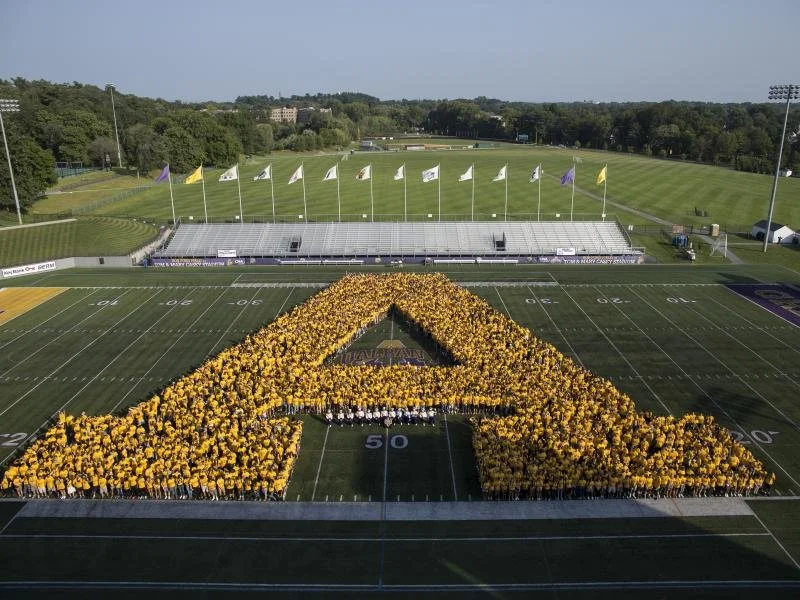Advisory Services Testimonials
Reflections on NASPA Advisory Services from Higher Education Leaders
Our services are strengthened by, and stand out as a result of, the direct involvement of higher education executives from concept through delivery. These executives range from a college president to vice presidents of student affairs to specific subject matter experts. Our review framework and services are informed by, and infused with, these critical perspectives. Read what higher education and student affairs executives are saying about NASPA Advisory Services below.
Fred C. McCall, Vice President for Student Engagement and Transformation and Dean of Students
“It was beneficial to have an outside perspective from experts in the field to validate the work and the direction of the Division. The process allowed folks across campus to speak candidly and feel heard. The credibility of the NASPA brand brought validity to the process and the recommendations and we were able to create a tangible road map for our future strategic planning work.”
Kawanna Leggett, Senior Vice President for Student Affairs, Loyola Marymount University
“Upon the announcement of the retirement of the long-time senior vice president, my institution prepared the Division of Student Affairs to engage in an external review with NASPA Advisory Services. This review was timed so that the new senior vice president would immediately be presented with self-assessment data and a comprehensive report on the status of the Division. As a new chief student affairs officer, the comprehensive report has been an invaluable tool for my onboarding. The report provided me with a road map and supporting evidence to help guide decision-making. I anticipate this report will continue to stay within arm’s reach during my first year in this position.”
Will Simpkins, Vice President for Student Affairs, Metropolitan State University of Denver
“We intentionally sought to complete a divisional review 5 years after we were formed as a first step in initiating a full departmental external review schedule. The NASPA staff were incredibly supportive in the process of preparing for the report and our reviewers arrived with a depth of understanding that I found refreshing. While it was validating to know that the structures of our work were deemed sound (i.e., we had all the right policies and processes to support student learning and staff development), it was the organizational cultural findings that were the most significant for MSU Denver Student Affairs. Thanks to our reviewers, we were able to connect our divisional strategic plan to recent workplace surveys to better understand what our team needs to thrive. This service from NASPA is an extraordinary opportunity to better understand how your division is functioning.”
Paz Olivérez, Vice President for Student Affairs, California State University, San Bernardino
“As a new Vice President for Student Affairs, I aimed to engage in a division re-organization and strategic planning process in my first year. While there were some things that were very evident to me about the division from my early observations and conversations, I believed a NASPA Advisory Services external review could offer more in-depth insight to inform my work in the first year. Within a few months of receiving the final report from the review, we continued our work with NASPA Advisory Services where they provided guidance and support through a division-wide strategic planning process that produced goals and objectives for a three-year strategic plan. These efforts allowed us to work with division leadership and frontline staff in all 21 units in our division to identify strategies, outcomes, and measures for all objectives in our strategic plan.”
Jody Stone, Dean of Students, Eastern Illinois University
“Our institution learned numerous new findings and strategies to focus our efforts to improve our Fraternity and Sorority Life experience for our students at Eastern Illinois University. We had a University task force that oversaw and worked with NASPA Advisory Services. Our task force, with the findings and best practices offered by NASPA Advisory Services, established a formal and final report to the University President. We now have a clear strategic plan toward revitalizing our Fraternity and Sorority Life experiences thanks to NASPA Advisory Services!”
Michael A. Baston, President, Rockland Community College (former)
“NASPA Advisory Services is a real gift to the profession. For so long, making the case to support the work of student affairs has been a struggle in both large and small institutions. This is in part due to the fact that our work has not always been undergirded with the level of peer review and guidance necessary to move forward with focus and quality execution strategies. NASPA Advisory Services provide opportunities for reflective practice that fosters greater insight and action planning at rates accessible to a diversity of institutional types. I’m proud to be a part of this great, new addition to the family of support and services offered by NASPA!”
Rhode Island College
The Rhode Island College president used an external review to support the on-boarding and goal setting of a new vice president overseeing a
re-organized Division of Student Success.
-
Division of Student Success
Situation
Established in 1854, Rhode Island College is the state’s first public institution of higher education. Although originally founded to provide teacher preparation for the young people of Rhode Island, the institution has evolved into a comprehensive institution of higher education. Rhode Island College is a four-year public institution located in suburban Rhode Island.
In alignment with the College’s mission, the Division of Student Success provides services to nearly 8,500 students through the following programs: Undergraduate Admissions, the Career Development Center, Residential Life and Housing, the Counseling Center, Health Services, Intercollegiate Athletics and Recreation, the Preparatory Enrollment Program, Upward Bound, the Student Union, and Student Activities.
Approach
Upon his arrival to the institution, the president of Rhode Island College was interested in reorganizing student affairs into a more comprehensive Division of Student Success. He engaged NASPA Advisory Services to conduct an external review of the division while concurrently conducting a national search for the position of vice president for student success. The goal of the external review with NASPA Advisory Services was to provide the new vice president with an extensive report of the division to serve as both an orienting resource and roadmap.
NASPA worked directly with the president and interim vice president to conduct a guided self-assessment using P.R.A.C.T.I.C.E.S. The interim vice president identified 18 Rhode Island College members to complete the P.R.A.C.T.I.C.E.S. self-assessment. NASPA administered the self-assessment over a three-week period and compiled the responses into nine reports for each of the P.R.A.C.T.I.C.E.S. components.
NASPA identified two reviewers that had significant experience with four-year, public institutions with student affairs programs and services similar to Rhode Island College. In tandem with NASPA staff, the reviewers conducted telephone interviews with eight direct reports to the interim vice president. The purpose of these interviews was to gain insights on the different areas of the division prior to the campus visit. During the campus visit, the NASPA Review Team conducted eleven meetings with over 50 members of the Rhode Island College community. Following the campus visit, the Review Team compiled a comprehensive report detailing findings, analysis, and recommendations that were presented to the interim vice president.
Results
NASPA’s report was shared with the incoming and inaugural vice president for student success in May of 2017 as part of planning and on-boarding materials. Upon his arrival in July of 2017, NASPA’s recommendations provided guidance for setting early targets for year one around staffing challenges, inequities, and opportunities to clarify roles. The vice president shared the report with the University’s executive team, academic leadership, and entire Division of Student Success as a framework for some of the goals and measurable objectives for the first year of the newly reorganized Division’s work. It was not collecting dust. “To be 100% clear, I have never had a better on-boarding document than the NASPA report. This is not my first vice presidency, and this transition was made much smoother than my start in any prior role due to the insight provided by the review,” noted vice president for student success, Dr. Jason Meriwether.
The report also exists as a living and breathing foundation for the Division’s three-year strategic plan. The guidance from NASPA framed a number of departmental plans, and was the basis of a discussion during the Division’s leadership retreat. The report was also used as an orientation tool as part of the on-boarding of two new assistant vice presidents who began working in July and August 2018.
The report provided an important record of the optimism, fears, and concerns associated with the merging of enrollment management, student affairs, athletics, and the academic support areas to become the Division of Student Success. Most of all, the report provided a tangible place from which the Division could measure its work and chart progress.
University at Albany
With the start of a new University president, the University at Albany vice president for student affairs engaged his division in an external review to detail strengths and opportunities for development.
-
Division of Student Affairs
Situation
Located in the capital of New York State, University at Albany (UAlbany) is a four-year, Research 1 public institution. Originally founded as a normal school for teacher education in 1844, UAlbany joined the State University of New York System and became a broad-based public research institution.
The twenty departments within the UAlbany Division of Student Affairs provide essential programs and services to the more than 17,000 students enrolled in undergraduate, graduate, and professional programs. The vice president for student affairs oversees the work of the following departments: Advocacy Center for Sexual Violence, Behavioral Health Promotion and Applied Research, Campus Center Management, Campus Recreation, Career and Professional Development, Center for Leadership and Service, Community Standards, Counseling and Psychological Services, Disability Resource Center, Intercultural Student Engagement, Neighborhood Life, Orientation and Transition Programs, Residential Life, Student Activities, Student Affairs Assessment and Planning, Student Affairs Communication and Marketing, Student Affairs Technology, Student Care Services, Student Health Services, and Student Involvement.
Approach
UAlbany had recently announced the appointment of Dr. Havidán Rodríguez as the new president. The vice president for student affairs approached NASPA to complete a comprehensive review of the Division of Student Affairs in order to detail strengths, on which it could build upon, and opportunities for further development.
In partnership with the vice president and Student Affairs Leadership Team (SALT), NASPA created a custom web portal for student affairs staff to participate in the P.R.A.C.T.I.C.E.S. self-assessment. SALT assigned a total of 22 staff members to participate in the various modules within the P.R.A.C.T.I.C.E.S. self-assessment. Upon the conclusion of the three-week period that the assessment was available, NASPA staff compiled the responses to inform the greater external review.
NASPA concurrently worked with the vice president to identify senior-level reviewers from the NASPA Advisory Services pool that had significant experience with four-year, public institutions with student affairs programs and services similar in mission and organizational composition to UAlbany. Prior to the on-campus portion of the review, the NASPA team reviewed materials provided by the vice president and conducted phone interviews with selected Student Affairs staff and campus partners.
The campus site visit coincided with the first month of UAlbany’s new president, which provided a unique opportunity to involve him in the review of Student Affairs. The campus site visit consisted of 14 individual and group meetings with the president, Student Affairs leadership and staff, faculty, campus partners, and students. Following the review, NASPA compiled a comprehensive report detailing findings, analysis, and recommendations from each stage of the review.
Results
After the NASPA report was delivered, the senior leadership team, comprised of the Division’s associate and assistant vice presidents, reviewed the document. Twenty recommendations were reviewed and solidified by the NASPA team and senior leadership team. The full report with twenty recommendations was then sent to the SALT team for review and use in their planning efforts. The report was also shared with the president and assistant vice provost for academic and resource planning.
The external review process affirmed that units within Student Affairs are student-focused and work diligently towards providing all students with an enriching student experience. As is the case for many divisions, the review helped UAlbany Student Affairs understand that they can always do better in telling their story and showcasing the resources and services their units provide students and how that leads to student success on campus. The review also pointed out areas of improvement which have been helpful in planning efforts.
The comprehensive report was used to guide the new Student Affairs Action Plan for 2018-2023. Associate and assistant vice presidents also worked with units to identify action steps to address specific NASPA recommendations for unit-level planning.
Participation in the NASPA review and information provided in the final report have strengthened the planning and development of Student Affairs’ strategic priorities for the next five years.
University of West Georgia
The University of West Georgia Division of Student Affairs and Enrollment Management participated in an external review as a means of engaging staff in critical self-reflection and to identify strengths and areas for improvement.
-
Division of Student Affairs and
Enrollment ManagementSituation
Founded in 1906, the University of West Georgia (UWG) began as a district agricultural and mechanical school and grew into a four-year college. Located one hour west of Atlanta, the University of West Georgia is the state’s sixth largest public university and enrolls nearly 13,500 students.
In alignment with the University’s focus on a “caring, student-centered community”, the Division of Student Affairs and Enrollment Management provides student-focused services across the following program areas: Admissions, Advising Center, Career Services, the Center for Academic Success, the Center for Adult Learners and Veterans, the Center for Student Involvement, the Counseling Center, Enrollment Services Center, Financial Aid, New Student Programs, Health Services, Housing and Residence Life, International Student Admissions and Programs, the Office of Community Standards, the Registrar, and University Recreation.
Approach
The vice president for student affairs and enrollment management engaged NASPA Advisory Services in a guided self-assessment using P.R.A.C.T.I.C.E.S. and an external review. The goal of the project was to engage staff across the division in a process of critical self-reflection, to get feedback on areas where the division was excelling, and to identify areas for improvement. A further goal was to understand how staff could better communicate across student life and enrollment management. Due to the University undergoing a separate, institution-wide administrative review, NASPA and the vice president mutually agreed to sequence the campus visit before the P.R.A.C.T.I.C.E.S. self-assessment.
NASPA identified two current vice presidents for student affairs and enrollment management from the NASPA Advisory Services pool to serve as reviewers for the project. The NASPA Review Team conducted an introductory call with the UWG vice president for student affairs and enrollment management to formally launch the project and review the P.R.A.C.T.I.C.E.S. framework and external review process. The vice president also shared nearly 60 documents including organizational charts, strategic plans, and departmental assessments that were reviewed by the NASPA Advisory Services Review Team.
The Review Team met with over 50 student affairs and enrollment management staff and students during a 1.5-day campus visit. The vice president then identified 63 staff to participate in the P.R.A.C.T.I.C.E.S. self-assessment. NASPA administered the self-assessment to these staff; the Review Team reviewed the results as part of its overall collection and analysis of project-related data.
Results
Following the campus visit and self-assessment, the NASPA Review Team compiled a report of findings, analysis, conclusions, and recommendations based on all project activities. This report, along with individual reports of each P.R.A.C.T.I.C.E.S. element, were then shared with the vice president. The NASPA team met with the vice president and his assistant vice president during the NASPA Annual Conference to discuss the report and to respond to questions and feedback.
The NASPA team also participated in a one-hour mini-presentation and question and answer session with approximately 100 members of the vice president’s expanded leadership team. This event occurred via video conference and provided staff an opportunity to engage with NASPA about report content.
The comprehensive report and ensuring discussions provided significant validation of current practices within the Division of Student Affairs and Enrollment Management as well as identification of important future improvements. Based on the results of the P.R.A.C.T.I.C.E.S. self-assessment and the external review, reviewers noted 16 recommendations touching on areas, including organizational structure improvements, student environment and safety, information and communication, student culture and engagement, and technology and data analysis. Additionally, the review highlighted many areas of excellence, validating internal beliefs about organizational health and effectiveness.
The review was highly successful, leading to new strategic directions for the Division. The review was effective in generating a tremendous amount of data and information that, along with normal strategic planning efforts, is being used to drive the Division’s success for the next several years. The review served as an effective tool to identify important aspects of practice and focus on improvements to attain greater student success.
Stonehill College
Three years out from a re-accreditation visit, the vice president for student affairs used the P.R.A.C.T.I.C.E.S. self-assessment to prepare staff and encourage them to think more critically about divisional assessment.
-
Division of Student Affairs
Situation
Founded as a Catholic institution of higher learning in 1948, Stonehill College is a small, private, not-for-profit institution located in suburban Massachusetts. Aligned with the College’s mission, Stonehill’s Student Affairs Division challenges its students to deepen their curiosity and think critically to become lifelong learners and ethical leaders within a diverse and global society
Under the leadership of the vice president for student affairs, Stonehill Student Affairs develops students through the following program and service areas: athletics and recreational sports, community standards, counseling services, health services, intercultural affairs, residence life, and student engagement. Over ninety percent of Stonehill’s nearly 2,500 undergraduate, enrolled students reside on campus.
Approach
The vice president for student affairs engaged NASPA Advisory Services in a guided self-assessment using P.R.A.C.T.I.C.E.S. Stonehill was approximately three years out from its reaccreditation visit by the New England Association of Schools and Colleges (NEASC). The vice president sought to involve her direct reports in a thorough exercise to energize their preparation for NEASC—a “pre-pre-accreditation activity.” The goal of using P.R.A.C.T.I.C.E.S. for this purpose was to identify perceived strengths and areas for additional emphasis across Student Affairs and encourage staff to think more critically about division-level assessment.
NASPA met via video conference with the vice president and associate vice president to introduce the P.R.A.C.T.I.C.E.S. self-assessment and orient them to NASPA’s customized web portal for Stonehill leaders to access the self-assessment. The vice president and associate vice president reviewed each P.R.A.C.T.I.C.E.S. element and determined that 14 staff would be assigned to multiple elements across all nine areas of P.R.A.C.T.I.C.E.S. NASPA administered the self-assessment over a three-week period, organized and reviewed responses, and produced nine individual reports corresponding to each of the P.R.A.C.T.I.C.E.S. elements. NASPA then delivered a video conference presentation of key findings of responses for each element to the vice president and her direct reports.
Results
The vice president used the P.R.A.C.T.I.C.E.S reports during divisional leadership team meetings to comprehensively review each element and develop action items. P.R.A.C.T.I.C.E.S. affirmed areas in which the Division was excelling and serving students well. It also confirmed, in concrete ways, specific areas that needed increased attention. Emphasis was placed on finalizing divisional learning outcomes and developing assessment measures for each department that align with the overarching learning outcomes.
P.R.A.C.T.I.C.E.S. motivated Student Affairs leaders to conduct their own internal review, assess their work based upon an objective, external framework, and develop a thoughtful and evidence-based plan to move the work of the Division forward. Completing the P.R.A.C.T.I.C.E.S. self-assessment illuminated the need for a comprehensive assessment strategy, and provided direction to focus on learning outcomes and assessment measures. The vice president referenced this work within broader senior leadership settings, including with the president and Institutional Research, which was highly regarded. The results and insights provided by the P.R.A.C.T.I.C.E.S. framework have also been used to inform the beginning stages of the accreditation process for the Division.










